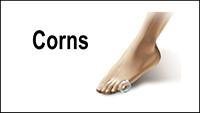
The Proper Procedures for Removing Corns and Calluses
- posted: Jun. 06, 2016
 Corns and calluses develop as a result of repeated friction or pressure to the skin, but are easily treatable. Corns can develop anywhere on the toes and on the balls of the feet, usually caused by arthritis or poorly-fitting shoes. Removing your corns and calluses involves soaking them in warm water until the skin softens, then using a pumice stone to gently file the layers of skin off. Afterwards, apply lotion or cream that has salicylic acid, ammonium lactate or urea everyday.
Corns and calluses develop as a result of repeated friction or pressure to the skin, but are easily treatable. Corns can develop anywhere on the toes and on the balls of the feet, usually caused by arthritis or poorly-fitting shoes. Removing your corns and calluses involves soaking them in warm water until the skin softens, then using a pumice stone to gently file the layers of skin off. Afterwards, apply lotion or cream that has salicylic acid, ammonium lactate or urea everyday.
For help dealing with corns and foot conditions, consult with Dr. Jeffrey Conforti of New Jersey. Dr. Conforti will attend to all of your foot and ankle needs.
Corns: What are they? And how do you get rid of them?
Corns are thickenings of the skin of your feet, often developed in areas under a lot of pressure. They are often layers of the skin that have become dry, rough, and painful, and are normally smaller than calluses.
Ways to Prevent Corns
There are many ways to get rid of corns such as wearing:
- Well-fitting socks
- Comfortable shoes that are not tight around your foot
- Shoes that offer support such as padding or cushioning
Treating Corns
Treating corns involves removing the dead skin that has built up in the specific area of the foot. Salicylic acid can help in getting rid of these corns because it dissolves keratin, which is the protein that makes up a majority of corns. Podiatrists recommend that people with diabetes not use salicylic acid and should consult with their podiatrist regarding the treatment of corns.
If you have any questions, please contact one of our offices located in Paramus and Clifton, NJ. We offer the newest diagnostic and treatment technologies for all your foot care needs.




